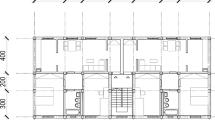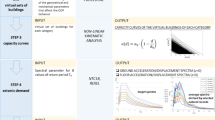Abstract
Fragility functions are an important tool in earthquake engineering, used to compute the probabilities of different damage states as a function of seismic response. They can be developed for large systems like buildings and bridges, as well as for individual structural and non-structural components, such as those used in the FEMA P-58 Seismic Performance Assessment Procedure. There are currently a number of problems associated with some P-58 non-structural mechanical component fragility functions and related loss predictions, including non-convergence when fitting the fragility functions in some cases and non-monotonic loss predictions. In this study, we recommend improvements to these fragility functions and loss predictions. Firstly, we recommend using the maximum likelihood method to fit the fragility functions to the underlying empirical data. This mitigates the non-convergence problems when fitting and makes predictions that better align with damage observed in past events. To compute predicted losses for anchored mechanical components, it is necessary to additionally consider anchorage damage, which can be predicted using fragility functions based on building code provisions. We recommend refining the current FEMA P-58 method for predicting anchored mechanical component losses, such that component and anchorage damage are calculated directly according to their corresponding fragility functions. The proposed method yields more intuitive loss predictions that vary monotonically with anchorage capacity. It also leads to better predictions of losses relative to damage observed in previous events. If implemented, the recommendations made in this paper would enhance the FEMA P-58 Seismic Performance Assessment Procedure.








Similar content being viewed by others
Change history
29 January 2019
Unfortunately, Eqs. 2, 4 and 5 of the associated paper are published incorrectly.
References
Agresti A (2013) Categorical data analysis. Wiley, Hoboken
Akkar S, Sucuoğlu H, Yakut A (2005) Displacement-based fragility functions for low-and mid-rise ordinary concrete buildings. Earthq Spectra 21(4):901–927
ASCE (2010) Minimum design loads for buildings and other structures, ASCE/SEI 7–10. American Society of Civil Engineers, Reston
ASCE (2016) Minimum design loads for buildings and other structures, ASCE/SEI 7–16. American Society of Civil Engineers, Reston
Badillo-Almaraz H, Whittaker AS, Reinhorn AM (2007) Seismic fragility of suspended ceiling systems. Earthq Spectra 23(1):21–40
Baker JW (2015) Efficient analytical fragility function fitting using dynamic structural analysis. Earthq Spectra 31(1):579–599
Bradley BA (2010) Epistemic uncertainties in component fragility functions. Earthq Spectra 26(1):41–62
Choe DE, Gardoni P, Rosowsky D, Haukaas T (2008) Probabilistic capacity models and seismic fragility estimates for RC columns subject to corrosion. Reliab Eng Syst Saf 93(3):383–393
Colombi M, Borzi B, Crowley H, Onida M, Meroni F, Pinho R (2008) Deriving vulnerability curves using Italian earthquake damage data. Bull Earthq Eng 6(3):485–504
FEMA (2012a) FEMA P-58-1: seismic performance assessment of buildings. Methodology, vol 1. Federal Emergency Management Agency, Washington
FEMA (2012b) FEMA P-58-2: seismic performance assessment of buildings. Implementation guide, vol 2. Federal Emergency Management Agency, Washington
Gardoni P, Der Kiureghian A, Mosalam KM (2002) Probabilistic capacity models and fragility estimates for reinforced concrete columns based on experimental observations. J Eng Mech 128(10):1024–1038
Huo Y, Zhang J (2012) Effects of pounding and skewness on seismic responses of typical multispan highway bridges using the fragility function method. J Bridge Eng 18(6):499–515
Kaufman RL (2013) Heteroskedasticity in regression: detection and correction, vol 172. Sage Publications, Thousand Oaks
Kennedy R, Ravindra M (1984) Seismic fragilities for nuclear power plant risk studies. Nucl Eng Des 79(1):47–68
Lallemant D, Kiremidjian A, Burton H (2015) Statistical procedures for developing earthquake damage fragility curves. Earthq Eng Struct Dyn 44(9):1373–1389
Lopez Garcia D, Soong T (2003) Sliding fragility of block-type non-structural components. Part 1: unrestrained components. Earthq Eng Struct Dyn 32(1):111–129
Mosleh A, Apostolakis G (1986) The assessment of probability distributions from expert opinions with an application to seismic fragility curves. Risk Anal 6(4):447–461
Naeim F (1997) Seismic performance of extensively instrumented buildings an interactive information system. CSMIP report
Naeim F, Lobo R (1998) Performance of non-structural components during the January 17, 1994 Northridge Earthquake—case studies of six instrumented multistory buildings. In: Proceedings of the seminar on seismic design, retrofit, and performance of nonstructural components, ATC-29-1, San Francisco, CA, Citeseer, pp 107–119
Nielson BG (2005) Analytical fragility curves for highway bridges in moderate seismic zones. Ph.D. thesis, Georgia Institute of Technology
Pagni CA, Lowes LN (2006) Fragility functions for older reinforced concrete beam-column joints. Earthq Spectra 22(1):215–238
Porter K (2011) Fragility of mechanical, electrical and plumbing equipment considering installation conditions. BD-3.9.10. Federal Emergency Management Agency, Washington
Porter K, Kennedy R, Bachman R (2007) Creating fragility functions for performance-based earthquake engineering. Earthq Spectra 23(2):471–489
Porter KA, Kiremidjian AS, LeGrue JS (2001) Assembly-based vulnerability of buildings and its use in performance evaluation. Earthq spectra 17(2):291–312
Rojahn C (2000) Database on the performance of structures near strong-motion recordings: 1994 Northridge, California, earthquake, vol 38. The Applied Technology Council, Redwood City
Rossetto T, Elnashai A (2005) A new analytical procedure for the derivation of displacement-based vulnerability curves for populations of RC structures. Eng Struct 27(3):397–409
Rota M, Penna A, Strobbia C, Magenes G (2008) Direct derivation of fragility curves from Italian post-earthquake survey data. In: Proceedings of the 14th world conference on earthquake engineering, Beijing, China, October, pp 12–17
Rota M, Penna A, Magenes G (2010) A methodology for deriving analytical fragility curves for masonry buildings based on stochastic nonlinear analyses. Eng Struct 32(5):1312–1323
Sarabandi P, Pachakis D, King S, Kiremidjian A (2004) Empirical fragility functions from recent earthquakes. In: Proceedings of the 13th world conference on earthquake engineering, Vancouver, BC, Canada, August. Paper No. 1211
Shinozuka M, Feng MQ, Lee J, Naganuma T (2000) Statistical analysis of fragility curves. J Eng Mech 126(12):1224–1231
Singhal A, Kiremidjian AS (1996) Method for probabilistic evaluation of seismic structural damage. J Struct Eng 122(12):1459–1467
Acknowledgements
We thank an anonymous reviewer for comments that improved the quality of this manuscript. We appreciate helpful feedback received from Dustin Cook, Curt Haselton, Katie Fitzgerald Wade, and Brendon Bradley. We thank Farzad Naeim for providing a copy of the SMIP Information System, and for feedback on typical equipment installation conditions.
Author information
Authors and Affiliations
Corresponding author
Additional information
Publisher's Note
Springer Nature remains neutral with regard to jurisdictional claims in published maps and institutional affiliations.
Appendix
Appendix
1.1 Comparing mechanical component damage predictions with observed damage
See Table 3.
1.2 Sample calculations of anchored component repair cost predictions
Let \(EDP = 1\) g and \(\theta _a = 1\) g for both components. All other variable values are summarized in Table 2 of Sect. 3.3.
1.2.1 Chiller
Proposed procedure
First, calculate the probability of anchorage damage with Eq. 1, using the anchorage fragility parameters:
Then, calculate the probability of equipment damage with Eq. 1, using the equipment fragility parameters:
Finally, compute the expected repair cost using Eq. 10:
Current P-58 procedure
Since \(0.3\times \theta _e \le \theta _a\) and \(0.3\times \theta _a \le \theta _e\), select combined failure damage mode. First, calculate the probability of occurrence of the damage mode with Eq. 1, using the anchorage fragility parameters:
Then, compute the expected repair cost using Eq. 9:
Even though the probability of equipment failure is significant in this case, the expected repair cost predicted using the current P-58 procedure is low since it is restricted by the lower vulnerability of the anchorage.
1.2.2 Distribution panel
Proposed procedure
First, calculate the probability of anchorage damage with Eq. 1, using the anchorage fragility parameters:
Then, calculate the probability of equipment damage with Eq. 1, using the equipment fragility parameters:
Finally, compute the expected repair cost using Eq. 10:
Current P-58 procedure
Since \(0.3\times \theta _e \le \theta _a\) and \(0.3\times \theta _a \le \theta _e\), select combined failure damage mode. First, calculate the probability of occurrence of the damage mode with Eq. 1, using the anchorage fragility parameters:
Then, compute the expected repair cost using Eq. 9:
Even though the probability of equipment failure is extremely low in this case, the repair cost predicted using the current P-58 procedure is relatively large as it is inflated by the higher vulnerability of the anchorage.
1.3 Comparing anchored mechanical component repair cost predictions with observed damage
1.3.1 Calculating anchorage capacity
To calculate anchorage capacity, it is first necessary to obtain the anchorage system design resistance (\(\phi R_n\)), which is calculated according to ASCE/SEI 7-10 equations 13.3-1 to 13.3-3 as follows:
where \(a_p\) is a component amplification factor (assumed to be 1 for all components examined since we are calculating capacity), \(S_{DS}\) is the short period spectral acceleration value (see Table 5 of the Appendix for building-specific values), h is the height of the building relative to the ground, z is the height of the component in the building relative to the ground (equal to h in this case, since we are considering roof-level components), \(I_p\) is the component importance factor (equal to 1 for all components examined in this study) and \(R_p\) is a component response modification factor (equal to 2.5 or 6 for components examined in this study, depending on the component of interest). We assume that the anchorage has the brittle failure modes typical for concrete anchorage (FEMA 2012b), so the relevant equation to calculate median capacity is equation 3-2 in FEMA (2012a):
where \(\theta\) is the median anchorage capacity, \(C_q\) is an adjustment coefficient for construction quality, and \(\beta\) is the \(\beta\) parameter for the anchorage fragility function. \(C_q\) and \(\beta\) are both set equal to 0.5, in accordance with FEMA (2012b).
1.3.2 Component repair cost data
See Table 4.
1.3.3 Comparing predictions and observations
See Table 5.
Rights and permissions
About this article
Cite this article
Cremen, G., Baker, J.W. Improving FEMA P-58 non-structural component fragility functions and loss predictions. Bull Earthquake Eng 17, 1941–1960 (2019). https://doi.org/10.1007/s10518-018-00535-7
Received:
Accepted:
Published:
Issue Date:
DOI: https://doi.org/10.1007/s10518-018-00535-7




